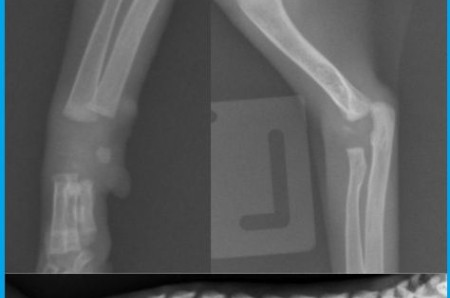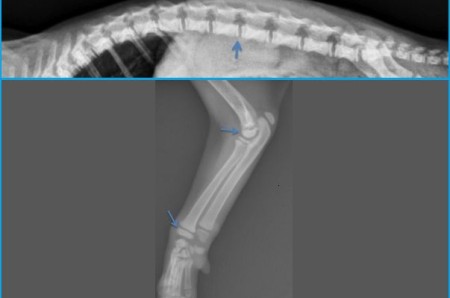Féline-Orthopédique : A case of congenital hypothyroidism in a cat
Anamnesis: The owner is worried because the kitten is the smallest of the litter and presents a marked growth retardation in relation to its congeners. Apart from that the cat has no other problems.
Auscultation: Kitten calm, heart rate 200, respiratory rate 36, mucosal pink, CRT <2 sec. The cat has a slightly disproportionate dwarfism, members are short compared to the trunk.
Blood test: it shows a mild anemia, mild hypercalcemia and a quantity of total serum T4 of 2 micrograms / dl.
Auscultation: Kitten calm, heart rate 200, respiratory rate 36, mucosal pink, CRT <2 sec. The cat has a slightly disproportionate dwarfism, members are short compared to the trunk.
Blood test: it shows a mild anemia, mild hypercalcemia and a quantity of total serum T4 of 2 micrograms / dl.
Additional tests: Abdominal ultrasound revealed a very small amount of abdominal fluid, kidneys that are subjectively small, with a demarcation between the cortex and medulla blurred.
Skeletal radiographs revealed delayed ossification of the epiphyses which is symmetric and generalized. The carpal bones are absent.
Conclusion:
- epiphyseal dysgenesis generalized, associated with growth retardation, slight anemia and a low T4: this is compatible with congenital hypothyroidism.
In the normal kitten, the TT4 is 2-3 times higher than adults.
A radiograph of a kitten of the same age range and was taken by comparison. See the second radio.
Discussion: Skeletal abnormalities such as delayed maturation and
epiphyseal dysgenesis are the hallmark of congenital hypo-
thyroidism. Delayed epiphyseal maturation is observed in the
vertebral bodies and long bones of affected kittens. Epiphy-
seal dysgenesis, which is characterized by a ragged epiphysis
with scattered foci of calcification, is observed in both hu-
mans and cats with untreated congenital hypothyroidism. Normal epiphyseal development proceeds from a single center; however, in hypothyroidism, thyroid deciency leads the development of multiple epiphyseal centers
each with its own calcification progression. Disorderly
epiphyseal calcification leads to secondary arthropathies in
children suffering from untreated congenital hypothyroid-
ism.
biblio:https://secure.vlsstore.com/ME2/Audiences/dirmod.asp?sid=&nm;=&type=Publishing&mod=Publications::Article&mid=8F3A7027421841978F18BE895F87F791&AudID=BE924B06C44442DE9033CA13B621B284&tier=4&id=1F5B3CD4001544D79C4293DAA65B03E5
Skeletal radiographs revealed delayed ossification of the epiphyses which is symmetric and generalized. The carpal bones are absent.
Conclusion:
- epiphyseal dysgenesis generalized, associated with growth retardation, slight anemia and a low T4: this is compatible with congenital hypothyroidism.
In the normal kitten, the TT4 is 2-3 times higher than adults.
A radiograph of a kitten of the same age range and was taken by comparison. See the second radio.
Discussion: Skeletal abnormalities such as delayed maturation and
epiphyseal dysgenesis are the hallmark of congenital hypo-
thyroidism. Delayed epiphyseal maturation is observed in the
vertebral bodies and long bones of affected kittens. Epiphy-
seal dysgenesis, which is characterized by a ragged epiphysis
with scattered foci of calcification, is observed in both hu-
mans and cats with untreated congenital hypothyroidism. Normal epiphyseal development proceeds from a single center; however, in hypothyroidism, thyroid deciency leads the development of multiple epiphyseal centers
each with its own calcification progression. Disorderly
epiphyseal calcification leads to secondary arthropathies in
children suffering from untreated congenital hypothyroid-
ism.
biblio:https://secure.vlsstore.com/ME2/Audiences/dirmod.asp?sid=&nm;=&type=Publishing&mod=Publications::Article&mid=8F3A7027421841978F18BE895F87F791&AudID=BE924B06C44442DE9033CA13B621B284&tier=4&id=1F5B3CD4001544D79C4293DAA65B03E5

